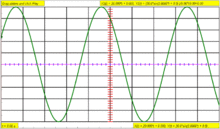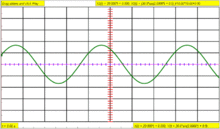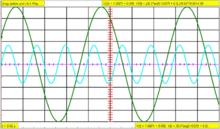#12 CRO PARTS AND ITS WORKING
CRO PARTS AND ITS WORKING

An oscilloscope, previously called an oscillograph, and informally known as a scope, CRO (for cathode-ray oscilloscope), or DSO (for the more modern digital storage oscilloscope), is a type of electronic test instrument that allows observation of constantly varying signal voltages, usually as a two-dimensional plot of one or more signals as a function of time. Other signals (such as sound or vibration) can be converted to voltages and displayed.
Description
The basic oscilloscope, as shown in the illustration, is typically divided into four sections: the display, vertical controls, horizontal controls and trigger controls. The display is usually a CRT or LCD panel which is laid out with both horizontal and vertical reference lines referred to as the graticule. In addition to the screen, most display sections are equipped with three basic controls: a focus knob, an intensity knob and a beam finder button.
The vertical section controls the amplitude of the displayed signal. This section carries a Volts-per-Division (Volts/Div) selector knob, an AC/DC/Ground selector switch and the vertical (primary) input for the instrument. Additionally, this section is typically equipped with the vertical beam position knob.
The horizontal section controls the time base or "sweep" of the instrument. The primary control is the Seconds-per-Division (Sec/Div) selector switch. Also included is a horizontal input for plotting dual X-Y axis signals. The horizontal beam position knob is generally located in this section.
Size and portability
Most modern oscilloscopes are lightweight, portable instruments that are compact enough to be easily carried by a single person. In addition to the portable units, the market offers a number of miniature battery-powered instruments for field service applications. Laboratory grade oscilloscopes, especially older units which use vacuum tubes, are generally bench-top devices or may be mounted into dedicated carts.
Inputs
The signal to be measured is fed to one of the input connectors, which is usually a coaxial connector such as a BNC or UHF type. Binding posts or banana plugs may be used for lower frequencies. If the signal source has its own coaxial connector, then a simple coaxial cable is used; otherwise, a specialized cable called a "scope probe", supplied with the oscilloscope, is used. In general, for routine use, an open wire test lead for connecting to the point being observed is not satisfactory, and a probe is generally necessary. General-purpose oscilloscopes usually present an input impedance of 1 megohm in parallel with a small but known capacitance such as 20 picofarads. This allows the use of standard oscilloscope probes.Scopes for use with very high frequencies may have 50‑ohm inputs, which must be either connected directly to a 50‑ohm signal source or used with Z0 or active probes.
Front panel controls
Focus control
This control adjusts CRT focus to obtain the sharpest, most-detailed trace. In practice, focus needs to be adjusted slightly when observing quite-different signals, which means that it needs to be an external control. Flat-panel displays do not need focus adjustments and therefore do not include this control.
Intensity control
This adjusts trace brightness. Slow traces on CRT oscilloscopes need less, and fast ones, especially if not often repeated, require more. On flat panels, however, trace brightness is essentially independent of sweep speed, because the internal signal processing effectively synthesizes the display from the digitized data.
Astigmatism
Can also be called "Shape" or "spot shape". Adjusts the relative voltages on two of the CRT anodes such that a displayed spot changes from elliptical in one plane through a circular spot to an ellipse at 90 degrees to the first. This control may be absent from simpler oscilloscope designs or may even be an internal control. It is not necessary with flat panel displays.
Beam finder
Modern oscilloscopes have direct-coupled deflection amplifiers, which means the trace could be deflected off-screen. They also might have their beam blanked without the operator knowing it. To help in restoring a visible display, the beam finder circuit overrides any blanking and limits the beam deflected to the visible portion of the screen. Beam-finder circuits often distort the trace while activated.
Graticule
The graticule is a grid of squares that serve as reference marks for measuring the displayed trace. These markings, whether located directly on the screen or on a removable plastic filter, usually consist of a 1 cm grid with closer tick marks (often at 2 mm) on the centre vertical and horizontal axis. One expects to see ten major divisions across the screen; the number of vertical major divisions varies. Comparing the grid markings with the waveform permits one to measure both voltage (vertical axis) and time (horizontal axis). Frequency can also be determined by measuring the waveform period and calculating its reciprocal.
On old and lower-cost CRT oscilloscopes the graticule is a sheet of plastic, often with light-diffusing markings and concealed lamps at the edge of the graticule. The lamps had a brightness control. Higher-cost instruments have the graticule marked on the inside face of the CRT, to eliminate parallax errors; better ones also had adjustable edge illumination with diffusing markings. (Diffusing markings appear bright.) Digital oscilloscopes, however, generate the graticule markings on the display in the same way as the trace.
External graticules also protect the glass face of the CRT from accidental impact. Some CRT oscilloscopes with internal graticules have an unmarked tinted sheet plastic light filter to enhance trace contrast; this also serves to protect the faceplate of the CRT.
Accuracy and resolution of measurements using a graticule is relatively limited; better instruments sometimes have movable bright markers on the trace that permit internal circuits to make more refined measurements.
Both calibrated vertical sensitivity and calibrated horizontal time are set in 1 - 2 - 5 - 10 steps. This leads, however, to some awkward interpretations of minor divisions
Timebase controls
These select the horizontal speed of the CRT's spot as it creates the trace; this process is commonly referred to as the sweep. In all but the least-costly modern oscilloscopes, the sweep speed is selectable and calibrated in units of time per major graticule division. Quite a wide range of sweep speeds is generally provided, from seconds to as fast as picoseconds (in the fastest) per division. Usually, a continuously-variable control (often a knob in front of the calibrated selector knob) offers uncalibrated speeds, typically slower than calibrated. This control provides a range somewhat greater than that of consecutive calibrated steps, making any speed available between the extremes.
Holdoff control
Found on some better analog oscilloscopes, this varies the time (holdoff) during which the sweep circuit ignores triggers. It provides a stable display of some repetitive events in which some triggers would create confusing displays. It is usually set to minimum, because a longer time decreases the number of sweeps per second, resulting in a dimmer trace. See Holdoff for a more detailed description.
Vertical sensitivity, coupling, and polarity controls
To accommodate a wide range of input amplitudes, a switch selects calibrated sensitivity of the vertical deflection. Another control, often in front of the calibrated-selector knob, offers a continuously-variable sensitivity over a limited range from calibrated to less-sensitive settings.
Often the observed signal is offset by a steady component, and only the changes are of interest. A switch (AC position) connects a capacitor in series with the input that passes only the changes (provided that they are not too slow -- "slow" would mean visible). However, when the signal has a fixed offset of interest, or changes quite slowly, the input is connected directly (DC switch position). Most oscilloscopes offer the DC input option. For convenience, to see where zero volts input currently shows on the screen, many oscilloscopes have a third switch position (GND) that disconnects the input and grounds it. Often, in this case, the user centers the trace with the Vertical Position control.
Better oscilloscopes have a polarity selector. Normally, a positive input moves the trace upward, but this permits inverting—positive deflects the trace downward.
Horizontal sensitivity control
This control is found only on more elaborate oscilloscopes; it offers adjustable sensitivity for external horizontal inputs.
Vertical position control
The vertical position control moves the whole displayed trace up and down. It is used to set the no-input trace exactly on the center line of the graticule, but also permits offsetting vertically by a limited amount. With direct coupling, adjustment of this control can compensate for a limited DC component of an input.
Horizontal position control
The horizontal position control moves the display sidewise. It usually sets the left end of the trace at the left edge of the graticule, but it can displace the whole trace when desired. This control also moves the X-Y mode traces sidewise in some instruments, and can compensate for a limited DC component as for vertical position.
Dual-trace controls
Each input channel usually has its own set of sensitivity, coupling, and position controls, although some four-trace oscilloscopes have only minimal controls for their third and fourth channels.
Dual-trace oscilloscopes have a mode switch to select either channel alone, both channels, or (in some) an X‑Y display, which uses the second channel for X deflection. When both channels are displayed, the type of channel switching can be selected on some oscilloscopes; on others, the type depends upon time base setting. If manually selectable, channel switching can be free-running (asynchronous), or between consecutive sweeps.
.
.
.
.
.
If you want more books, slide, ppt's and notes,Request in the comment section.
Visit the site for more knowledge and share this site link to the needy one.
Thank You...
.




Comments
Post a Comment